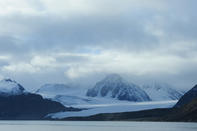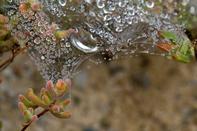
Snow in South Africa
When falling at low altitudes, not only on mountains, snow occurs in areas at high latitudes - pole-ward of latitude 35°N and 35°S - the most northern and southern parts of the earth. South Africa is in the warmer and temperate mid-latitudes - north of 35°S - and thus most of the country does not receive any snow.
Only the higher mountains regularly receive a few snowfalls every winter. Snowfalls are light and the snow melts quickly after each fall. Snow is formed in dense, thick stratiform clouds that could also bring abundant rain.
Melting snow leads to runoff, contributing to the filling of dams and maintaining winter flows of rivers in summer rainfall areas. Compared with rain, the contribution of snow as a source of water for farming is very small. The Koue Bokkeveld near Ceres in the Western Cape is the only major farming area, with crops like deciduous fruits and potatoes, where snow falls a few times each winter in orchards and croplands.
Mist

Mist, or fog, is a dense layer of tiny water droplets in the lower atmosphere – often down to ground level. Mist and fog are mostly seen in summer and usually from late afternoon until early morning, but evaporates with higher temperatures. In undulating hilly areas, it is seen in the lower-lying areas only.
Mist is common along the cool areas of South Africa, especially during summer and in the mid-altitude areas below the eastern escarpment of the country. The KwaZulu-Natal Midlands mist belt area is the best-known of these mid-altitude areas, forming a special ecological zone in the province.
Early summer mist has been described as a crop production hazard in the KwaZulu-Natal mist belt. Mist belt areas are unsuitable for production of forage sorghum, because of the hazard of fungal diseases like rust and ergot, which thrive under such moist conditions. These fungal diseases produce toxins, which may affect cattle grazing on sorghum.
On the other hand, mist belt conditions are described as ideal for avocado production, a crop, which requires high relative humidities. Thus, mist must be considered when deciding on which crop to plant in a farming area.
Dew

Dew is water in the form of tiny droplets forming on exposed objects in the morning, mainly, but also in the evening. This condensation of water vapour into droplets depends on a specific temperature, this is called the dew point. When a surface radiates heat and the surface temperature falls to below dew point, condensation occurs and dew forms.
Dew formation requires a clear, cloudless, windless night. Dew occurs in most areas of South Africa, even in arid areas such as along the cool west coast and adjoining interior areas of South Africa. The frequent occurrence of dew leads to increased disease hazards in crops such as potatoes, soybeans and Swiss chard. Dew forming on plant leaves, creates favourable moist conditions for the development of fungal diseases.
Source Water Research Commission